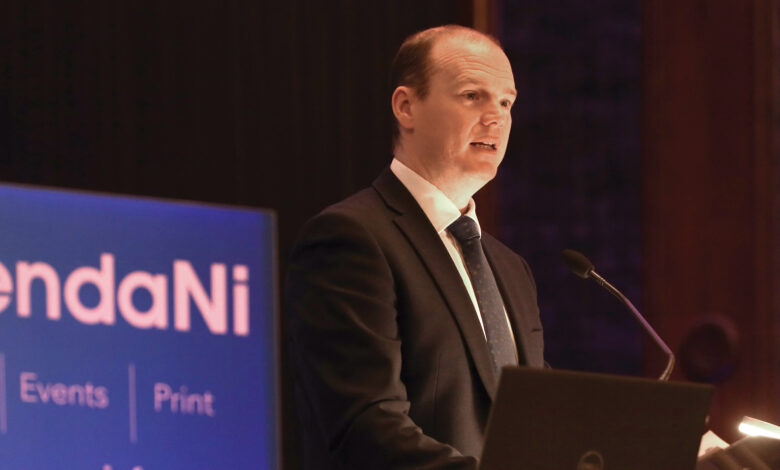Q&A: Minister Gordon Lyons MLA

A decade on from the reforms to local government in Northern Ireland, Minister for Communities Gordon Lyons MLA sits down with agendaNi and discusses the evolution of the local government system.
Ten years on from the implementation of the Local Government Reform Programme, what is the continued significance of the new 11-council model?
As we mark the 10th anniversary, it is clear that many opportunities have been grasped, but challenges remain. The transfer of planning responsibilities and the introduction of Community Planning has brought decision-making closer to local communities, ensuring services are tailored to meet specific needs.
My department recently published a report – Impact of Local Government Reform on Service Delivery. This report confirmed that the reform process has brought about many positive changes and acknowledged areas for improvement and efficiency.
Councils have also driven economic regeneration by partnering with businesses, investing in infrastructure, and promoting tourism. Initiatives like labour market partnerships and the investment in City and Growth deals are creating jobs, boosting entrepreneurship, and enhancing connectivity.
How have Northern Ireland’s 11 councils demonstrated an ability to innovate and collaborate in the delivery of critical public services?
The reform has provided councils with the opportunity to explore new ways of delivering services. Many councils have embraced technology and digital solutions to improve service delivery and engage with their communities. For example – the use of digital platforms and virtual tours has expanded access to cultural, heritage, and tourism experiences, allowing residents and visitors to explore and learn about the community’s history and attractions.
Overall, the use of digital technology has resulted in greater accessibility, transparency, and citizen participation in local government decision-making processes and service delivery.
Community planning partnerships have also been instrumental in promoting joint working between local government, central government, community organisations, and other stakeholders. The value of effective community planning and partnership working was particularly evident during the Covid-19 pandemic. Additional funding was allocated through the Community Support Programme for community-led initiatives and to assist those who needed our help the most. My department worked in partnership with central and local government to develop and deliver Covid recovery regeneration programmes with a total investment of almost £50 million to support our towns, cities and villages to recover from the impact of the pandemic.
Shared services have been established in various areas, such as home safety, tobacco, infectious disease, and air quality monitoring. These shared services help leverage funding from external stakeholders and promote quality and productivity.
Tourism is another important aspect of local government collaboration. Tourism NI works with all councils to achieve economies of scale in tourism and marketing efforts. By pooling resources and expertise, councils can attract more visitors, generate economic growth, and enhance the tourism experience in the region. We had enormous success with this in recent years, with tourist attractions such as The Irish Open at Royal County Down, the food and cider weekend in Armagh, the Halloween festival in Londonderry, The Giant Adventures in the Mournes and the Stairway to Heaven in Fermanagh. The Open in Royal Portrush in 2019 was also a huge success and is returning again later this year.
Councils also came together on several initiatives and programs, such as the Go for It Programme, Belfast Region City Deal, Digital Voucher Scheme, Levelling up Fund, and the development of the Support Hub. Between 2017 and 2024 my department, in partnership with DAERA and local councils, delivered an Access and Inclusion capital programme aimed at improving access to a range of culture arts and active recreation venues, with over £5.5 million invested in approximately 300 projects.
Local government also plays a key role in civil contingencies as was the case during the recovery phase from Storm Éowyn. I worked closely with my local government colleagues to activate the Scheme of Emergency Financial Assistance to ensure immediate, on-the-ground support to the people affected. Each council played a leading role by setting up community assistance centres within their areas and working closely with the voluntary and community sector to provide urgent support for those most in need. This was a real team effort and a good example of what can be achieved when we work together.
“We can achieve so much more when we work well together to create thriving communities and places where people want to live, work and invest.”
How has the relationship between local government and the Executive evolved since the reform?
I believe that, if we are going to realise the ambition of the Executive’s Programme for Government, local government will be key in helping us deliver successful outcomes for our citizens. Relationships between central and local government have been further strengthened through the establishment of the Partnership Panel (the panel) which I chair.
The panel meets twice a year and is comprised of the Executive ministers, NILGA representatives, and councillors representing all 11 local councils. The Panel considers areas of mutual interest, explores opportunities for innovative working and joint policy formation.
At official level, this is further enhanced through the Permanent Secretaries’ Group (PSG) and the Society of Local Government Chief Executives (SOLACE) Engagement Forum. This forum is another mechanism through which central and local government are working together. We can achieve so much more when we work well together to create thriving communities and places where people want to live, work, and invest.
Have there been any quantifiable improvements in service delivery or cost effectiveness as a direct result of the reform?
Yes, research by my department identified £21.5 million of efficiency savings across the 11 councils. The actual amount is more as the research only covered the seven-year period up to 31 March 2022. As councils continue to work through the change agenda, many more benefits and efficiencies are projected to be achieved in the future, and I believe there is scope for further savings to be made.
Of course, since 2014, councils have a statutory responsibility to make arrangements for, and to report on, continuous improvement in their functions or services. These performance improvement plans are published on councils’ websites and actively seek input from service users to identify areas for improvement and ensure that services meet the needs of the community. The Local Government Auditor then assesses councils’ achievements against targets set in the plans.
Economies of scale have been achieved in various aspects of council activity, such as waste management, procurement, and contract management.
What have been the most significant challenges faced by local government in adapting to an enhanced role and remit?
As is normal when large organisations merge, councils faced many challenges, mainly within the areas of human resources and finance. The challenges presented by issues such as capacity, disparities in terms and conditions for employees, difficulties in integrating different working practices, and challenging budgets for transferred functions should not be underestimated either.
Councils still wrestle with many of these issues, however, overall, I believe that reform has brought transformation to local government. It is well-positioned to meet the needs of communities and drive the region’s future growth and development.
“People are at the heart of all that we do, and we need to win hearts and minds if we are to achieve our ambition of creating thriving communities and places where people want to live, work, and invest.”
What transferable lessons from the reform process can be used to inform future structural change management at local or central government level?
As with any change management process, by sharing lessons learnt we can help inform and improve future structural change. People are at the heart of all that we do, and we need to win hearts and minds if we are to achieve our ambition of creating thriving communities and places where people want to live, work, and invest. We still have much to learn from this process and we will continue to monitor the progress of councils as they transition.
How has direct collaboration between the Executive/British Government and individual councils through City and Growth deals impacted the policy landscape?
There are four City and Growth deals across Northern Ireland that cover all of the 11 council areas. Each of the deals contain both Executive and UK Government funding. This will result in a total of £1.2 billion in central government funding over the next decade or so, representing one of the largest schemes of investment in history for local government. This investment will support the creation of up to 20,000 jobs, deliver a transformative digital innovation programme, improve connections through investment in infrastructure and create world-class visitor attractions which will regenerate towns and cities across Northern Ireland.
While the governance and delivery arrangements were challenging to begin with, my department played a leading role by working with partners across the Executive and in local government. We can learn a lot from how we are working together on City and Growth Deal delivery. This partnership has resulted in sharing of best practice, improved outcomes, and a more joined up approach between central and local government.
To what extent has local government demonstrated its potential to deliver in relation to change and economy growth?
The establishment of the 11 new councils in 2015 was not only an enormous organisational change involving, work-force mergers, physical relocation, new elections, and new processes etc., but it was also a significant cultural change, as councils stepped up to take on their new powers which included planning, community development, local tourism, and economic development. It gave councils more responsibility to ensure that, quite rightly, more decisions and services were tailored to better meet local needs.
It has empowered local government to drive economic development and job creation through initiatives such as business support programs, investment incentives, and partnerships with local businesses and educational institutions. This has resulted in increased investment, growth in key sectors, and the attraction of new businesses to the region.
My department worked closely with local government partners to establish Labour Market Partnerships (LMPs) since 2020/21 across all 11 council areas. This is an excellent example of how a multi-agency, collaborative approach involving local experts and practitioners can improve employability outcomes and labour market conditions. LMPs focus on evidenced priorities and interventions appropriate to their individual area, and can change the scope of their delivery to meet the changing needs of the labour market. LMPs are designed to avoid duplication, and interventions are planned around filling any gaps in existing local labour market provision or providing additionality.
From 2021/22 to 2023/24 LMPs achieved a 70 per cent completion rate for provision delivery, supporting almost 3,000 people into employment or self-employment. LMPs have also helped those in work to increase their hours or earnings while also enabling over 3,000 local citizens to gain a new qualification.
In 2018, the House of Commons’ Northern Ireland Affairs Committee recommended that an independent review of local government powers and finances be undertaken. What opportunities are there for further local government empowerment/enhanced devolution of powers in the years ahead?
In the Programme for Government (PfG): Our Plan: Doing What Matters Most, the Executive has committed to working together to deliver nine priorities with the goal of improving the wellbeing of everyone living and working here. Local government played a key role in the PfG consultation process and will be a delivery partner on many of the outcomes.
“Housing supply and ensuring the delivery of good quality, affordable and sustainable homes is one of my top priorities.”
Housing supply and ensuring the delivery of good quality, affordable, and sustainable homes is one of my top priorities. Last December [2024], I secured Executive approval for my Housing Supply Strategy and agreed with Executive colleagues to include ‘Provide More Social, Affordable and Sustainable Housing’ as one of the nine priorities in the PfG. The Housing Supply Strategy sets out a clear framework for a whole system approach to delivering the supply of homes we need over the next 15 years. Local government was directly involved in the process to develop the Strategy and will continue to play a key role going forward by ensuring there is an effective and efficient planning system in place that can help meet these ambitions. This includes the delivery of Local Development Plans (LDPs), which establish the zonings and policies to ensure spatial growth requirements of local areas can be met. My department continues to support local council planning teams sharing knowledge and information to ensure we maximise the opportunities for increasing housing supply through the LDP process.
The Landlord Registration Scheme is another example of councils taking on additional responsibility for delivery of services. The scheme transferred to councils on 1 March 2025, with Lisburn and Castlereagh City Council (LCCC) acting as lead council on behalf of all 11 councils. The benefits include more joined up work in the private rented sector; additional evidence/tools to support enforcement activity and consistency in management of the private rented sector.





